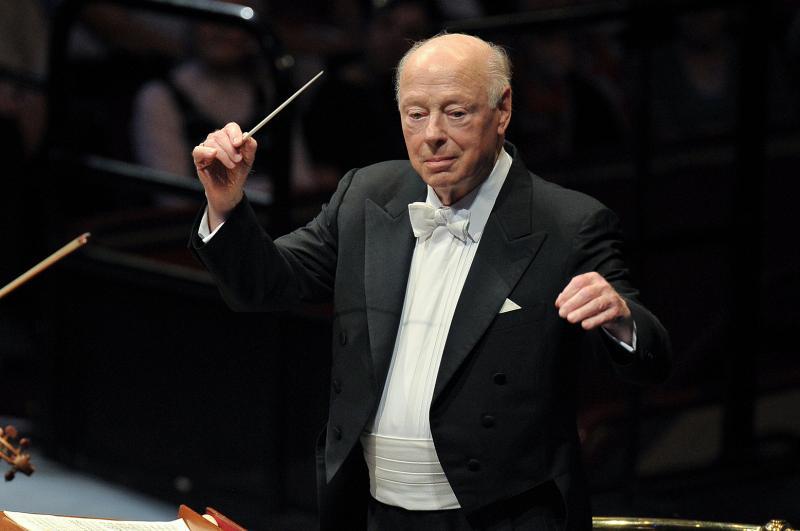LSO, Haitink, Barbican | reviews, news & interviews
LSO, Haitink, Barbican
LSO, Haitink, Barbican
The venerable conductor grasps the bigger picture, but details are lost

Bernard Haitink is one of the great Bruckner conductors of our time. His interpretations are expansive yet vivid and always go straight to the heart of the music. But he is also an old man, and physical frailty is increasingly inhibiting his work, reducing the spontaneity of his communication with the orchestra. The results are both frustrating and inspiring, with details lost and clarity of texture often compromised.
The Te Deum is often programmed as a substitute finale for the Ninth Symphony – even the composer himself condoned the idea – but Haitink sensibly placed it first in the programme, the better to speak for itself. As ever, Haitink took steady tempos, and always pushed for dynamic extremes. That combination proved challenging for the London Symphony Chorus, who were excellent in the louder passages, but lost focus in the quieter sections. The vocal soloists, Sally Matthews, Karen Cargill, Eric Cutler (pictured below by Dario Acosta) and Alessandro Spina, proved a well-matched and suitably dramatic ensemble. Haitink often demanded bold, declamatory expression from them, which suited Cutler’s robust Italianate tenor, while challenging some of Matthews’ high, sustained notes. The LSO, ever reliable, provided sturdy support, the trombones particularly impressive here.
Haitink’s bigger picture for the Ninth Symphony was evident from the opening bars, the atmosphere perfectly judged, beautifully led by the horn section. The tempo was slow, even by Haitink’s standards, and remained so throughout the movement. His Bruckner is a known quantity, but he is still able to surprise, especially in the way that he can introduce a new theme with a refreshing texture and buoyancy, always vibrant, even at his steady tempos. And the climaxes were gripping, emblazoned with brass, but with the density of sound provided by the strings, their tone finely controlled, even at the loudest dynamic.
But details were lacking, and listening for Haitink’s genius often meant listening beyond the foreground. He is always ready with a new tempo, but in the time he takes to express it, he drops the end of the previous phrase, leaving the orchestra directionless until the new section starts. His rubato is subtle, but when poorly communicated leads to ensemble problems, especially between the horns and trumpets. He even struggled to end the last chord of the first movement cleanly. Small problems all, but they add up.
Fortunately, the second and third movements were more successful. The driving pulse of the scherzo was suitably insistent, and powerfully conveyed by timpanist Antoine Bedewi. The more sectional nature of the movement allowed Haitink to focus on one tempo at a time, bringing greater clarity of texture. Conversely, the continuous flow of the Adagio also worked to his favour. This is music that is all about the bigger picture, and the sense of direction and line that he was able to project here was ideal. Dynamic extremes were delivered with ease by every section of the orchestra, building to a truly momentous climax (a good substitute for the missing finale, at least under Haitink’s baton) before coming to rest in the quietest of codas. The Wagner tubas here were at the very limit of perceptibility, yet their tuning and ensemble held firm. Haitink may not be the conductor he once was, but the superior playing of the London Symphony ensures that his greatness still shines through.
The future of Arts Journalism
You can stop theartsdesk.com closing!
We urgently need financing to survive. Our fundraising drive has thus far raised £49,000 but we need to reach £100,000 or we will be forced to close. Please contribute here: https://gofund.me/c3f6033d
And if you can forward this information to anyone who might assist, we’d be grateful.

Subscribe to theartsdesk.com
Thank you for continuing to read our work on theartsdesk.com. For unlimited access to every article in its entirety, including our archive of more than 15,000 pieces, we're asking for £5 per month or £40 per year. We feel it's a very good deal, and hope you do too.
To take a subscription now simply click here.
And if you're looking for that extra gift for a friend or family member, why not treat them to a theartsdesk.com gift subscription?
more Classical music
 Classical CDs: Bells, birdsong and braggadocio
British contemporary music, percussive piano concertos and a talented baritone sings Mozart
Classical CDs: Bells, birdsong and braggadocio
British contemporary music, percussive piano concertos and a talented baritone sings Mozart
 Siglo de Oro, Wigmore Hall review - electronic Lamentations and Trojan tragedy
Committed and intense performance of a newly-commissioned oratorio
Siglo de Oro, Wigmore Hall review - electronic Lamentations and Trojan tragedy
Committed and intense performance of a newly-commissioned oratorio
 Alfred Brendel 1931-2025 - a personal tribute
A master of feeling and intellect
Alfred Brendel 1931-2025 - a personal tribute
A master of feeling and intellect
 Aldeburgh Festival, Weekend 2 review - nine premieres, three young ensembles - and Allan Clayton
A solstice sunrise swim crowned the best of times at this phoenix of a festival
Aldeburgh Festival, Weekend 2 review - nine premieres, three young ensembles - and Allan Clayton
A solstice sunrise swim crowned the best of times at this phoenix of a festival
 RNCM International Diploma Artists, BBC Philharmonic, MediaCity, Salford review - spotting stars of tomorrow
Cream of the graduate crop from Manchester's Music College show what they can do
RNCM International Diploma Artists, BBC Philharmonic, MediaCity, Salford review - spotting stars of tomorrow
Cream of the graduate crop from Manchester's Music College show what they can do
 Classical CDs: Bells, whistles and bowing techniques
A great pianist's early recordings boxed up, plus classical string quartets, French piano trios and a big American symphony
Classical CDs: Bells, whistles and bowing techniques
A great pianist's early recordings boxed up, plus classical string quartets, French piano trios and a big American symphony
 Monteverdi Choir, English Baroque Soloists, Suzuki, St Martin-in-the-Fields review - the perfect temperature for Bach
A dream cantata date for Japanese maestro and local supergroup
Monteverdi Choir, English Baroque Soloists, Suzuki, St Martin-in-the-Fields review - the perfect temperature for Bach
A dream cantata date for Japanese maestro and local supergroup
 Aldeburgh Festival, Weekend 1 review - dance to the music of time
From Chekhovian opera to supernatural ballads, past passions return to life by the sea
Aldeburgh Festival, Weekend 1 review - dance to the music of time
From Chekhovian opera to supernatural ballads, past passions return to life by the sea
 Dandy, BBC Philharmonic, Storgårds, Bridgewater Hall, Manchester review - a destination attained
A powerful experience endorses Storgårds’ continued relationship with the orchestra
Dandy, BBC Philharmonic, Storgårds, Bridgewater Hall, Manchester review - a destination attained
A powerful experience endorses Storgårds’ continued relationship with the orchestra
 Hespèrion XXI, Savall, QEH review - an evening filled with laughter and light
An exhilarating exploration of innovation in 16th and 17th century repertoire
Hespèrion XXI, Savall, QEH review - an evening filled with laughter and light
An exhilarating exploration of innovation in 16th and 17th century repertoire

Add comment